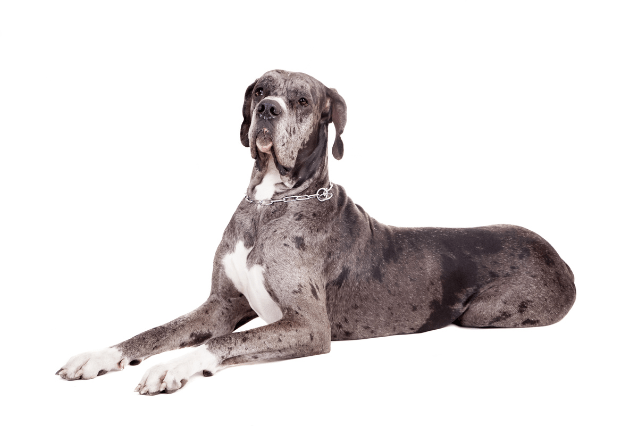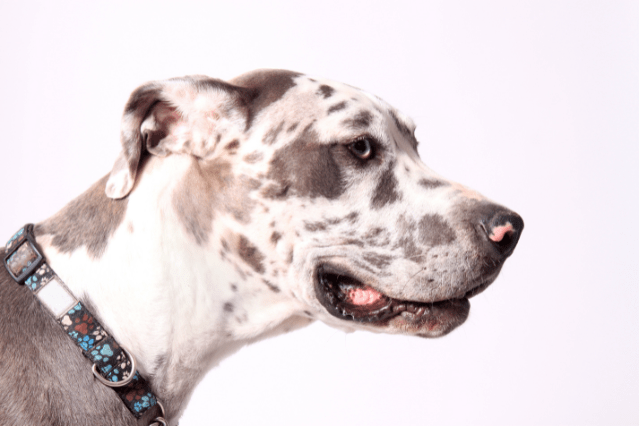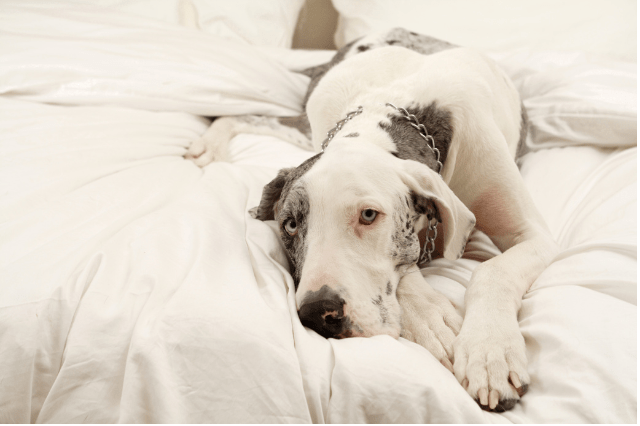Merle Great Dane – Everything You Need to Know About These Beautiful Big Dogs

Merle Great Danes are among the most elegant and preferable dog breeds worldwide. With a tight muscular body and a strong sense of alertness, these dogs pose protection. They show leadership and sensibility when it comes to being responsible. But what is the Merle gene? Does a Merle Great Dane puppy require a lot of training? Do Merle Danes come in many colors? Is it true that they have more health concerns?
Read on for some of the most interesting facts about the Merle gene and discover what makes these canines so unique and desirable.
A History Of The Merle Great Dane
The Great Dane descended from English Mastiffs and Greyhounds in Germany (so not Denmark)! They are large-sized dogs whose ancestors were quite fond of hunting. This dog breed developed around 400 years ago and was meant for boar hunting.
Great Danes are commonly referred to as “Deutsche Dogge” in Germany. The Merle Great Dane and Irish Wolfhound are relatives who are known as some of the largest breeds out there. Because of their size (not necessarily their temperament), Great Danes have been used as guard dogs for many years – they’re considered to be a scary dog breed!
What Does The Merle Great Dane Look Like?
Usually, around 30 inches tall, Merle Great Danes have long, graceful necks with athletic bodies. A large head with a deep-set jaw and almond-shaped eyes make them even more attractive. The males weigh between 120 and 200 pounds while females weigh between 100 to 130 pounds. So yes, they’re big – big enough to be considered horse-like dogs!
They have a square build with dark splotches upon a lighter color coat. Their ears are medium-sized, high-set, and folded close to the cheek. Some owners like to crop their pup’s ears and dock their tails for aesthetic reasons, although this is very controversial.
A color pattern that distinguishes them is the unique markings on their tail tip. Among all merles, the Blue Merle Great Dane is considered to have the most incredibly striking appearance.
Check out our blog on other merle dog breeds too!

Merle Great Dane Temperament
Merle Great Danes aren’t likely to develop behavioral problems as long as they’re trained well from an early age. However, they may fear small children. And sometimes, they may bump into babies accidentally, but it’s unlikely they will hurt or bite.
These pups aren’t rambunctious without reason and don’t bark excessively. While these furry friends are typically reserved around new people, they have a playful nature that also makes them misbehave.
When anxious, they may chew on furniture. They are powerful and elegant, yet also extremely loyal and silly. Behavioral training can keep them on track, but they are generally calm, loyal, affectionate, and always ready to protect their family.
Is The Merle Great Dane Hard To Train?
No. Your Merle Great Dane puppy is an intelligent dog that doesn’t require huge amounts of training. However, with consistency, even a little effort goes a long way. Start by teaching your Merle Great Dane the basics of sit, stay, leave it, and down.
If they don’t respond to these commands, try giving them a healthy treat, such as unsalted popcorn, instead. This will help them recognize the difference between acceptable and unacceptable behavior.
Training your Merle Great Dane is important to avoid aggressive or stubborn behavior later. Seek advice from a Merle Great Dane expert or professional trainer if you’re unsure.
How To Groom Your Merle Great Dane
The good news is that a Merle Great Dane has a very short, single-layer coat, which makes it easy to take care of. You can use a comb to brush and clean the coat about twice a week.
Cleaning and clipping nails once a month will do – if you’re not sure how, ask your groomer.
Dry food can stick to its teeth, so brush as needed. A bath every couple of months is sufficient but it’s good to occasionally check for fleas and ticks. Their trimming sessions can also be kept limited to the tail, face, and feet only.
How Much Exercise Does a Merle Great Dane Need?
This breed is fairly active and needs to be kept entertained. Their routine may include a daily walk and playing in a spacious yard. Puppies need 30 minutes to an hour of exercise a day. Adult Merle Great Danes, however, may require at least 1 to 2 hours of exercise.
Begin with short walks and small games while working your way up. Frequent and hard exercises can lead to bone and joint problems, especially when your pup is young.
Although active, Great Danes are known for sitting on the couch and watching TV with you (and not wanting to budge). If you need to get your pup up a bit more, try tempting them away with cute toys, and start with light exercise and gradually build your way up.

Is The Merle Great Dane A Good Swimmer?
Yes! They can swim well with proper training. Some can be great swimmers naturally, but it’s best to be cautious when taking them out to the water. It may take a few attempts before they get comfortable. Later on, you can introduce them to shallow water and gradually increase the amount of time they spend in it.
Be careful when allowing your dog to swim in the sea or pools as both chemicals and salt water can be bad for your pup if they drink it. Never force your pooch to swim if they don’t enjoy it. You can always take them for a long walk instead.
Are Merle Great Danes Rare?
Not necessarily. Every Merle Great Dane may have a unique pattern, but the breed isn’t rare. To earn extra money, some breeders may claim that they are rare. This usually applies to their specific color pattern or Merle gene and not the breed itself. Always make sure you do your research and get your dog from an ethical breeder. According to the Great Dane Club of America, there are a couple of important questions you should ask before adopting this breed.
Merle Great Dane Lifespan and Health
Merle Great Danes have a medium life span of 7-10 years, and the breed can suffer from various health problems like deafness and blindness.
Is the Merle Gene Bad?
It’s not bad if the Merle Great Dane has one copy of the Merle gene. But if a Great Dane puppy has two Merle genes, it becomes a Double Merle. And the Double Merle gene increases the risk of several health problems leading to issues such as displaced pupils or a malformed iris.
They also face gastric dilatation volvulus or bloating, and an increased risk of skin cancer, this is even truer for Double Merle Great Danes. Poor breeding practices can lead to Double Merle Great Danes.
A slow feeder dog bowl can help minimize the risk of bloat.
Luckily, the Double Merle gene is now easily detectable. Some Merle Great Dane puppies may also face mobility issues. But a proper diet and exercise can prevent or delay such health concerns.
You can also look for any signs of stress in Merle puppies like whining, trembling, reduced energy levels, sluggish behavior, uncontrolled urination, and diarrhea. This is because stress hormones loosen the bladder muscles.
Do All Merle Great Danes Have A Similar Pattern?
Generally, Merle Great Danes have white on the chest, black on the forelegs and hind legs, and a white-tipped black tail. This pattern is common among Merle Great Danes. However, individual patterns on the body and overall coat color (thanks to the Merle gene) may help you distinguish them from others.
Interesting Facts About Merle Great Danes
Undoubtedly, Great Danes have remained popular pets and are also famous in pop culture (remember Scooby-Doo?) They can reach the size of a small horse.
Their coat color is a result of a genetic “mutation” in the Merle gene. A Merle Great Dane will typically have blue eyes. Egyptian monuments of dogs around the age of 3000 B.C strikingly resemble Great Danes.
The American Great Dane is much smaller in size and has a sleeker physique than the European dog breed. As one of the most beautiful dogs, their eyes are almond-shaped and may change color after their first birthday.
What Makes the Merle Great Dane Coat Special?
Their fine coat is white or gray with irregular black patches of dark fur that covers the entire body. The Merle pattern refers to a coat with irregular-shaped patches of solid and diluted colors.
These patches are usually smaller on the face and larger on the body. This unique coat pattern can be passed down from one parent. The Merle pattern makes up about 15 to 20 percent of Merle Great Dane puppies.
Their coat is mottled with colors ranging from black to blue and brown to red. It is also very fine and resistant to shedding. Caused by an unstable Merle gene, this coat is glossy, short, thick, and smooth.

Is The Merle Great Dane Puppy Recognized by The AKC and UKC?
The Great Dane was first recognized in the 1880s. The United Kennel Club recognized the Great Dane in 1923. While the AKC recognizes the fawn Merle Great Dane as a purebred, it’s sometimes bred to have different colors.
The UKC however recognizes pale to dark gray and white Merle Great Dane puppies with a solid Merle pattern blanket or mantle pattern. The Merle Great Dane can be any color, though the Blue Merle Great Dane is the only fully-accepted variation.
Here are all the Great Dane colors accepted by the AKC.
What Is The Truth Behind The Merle Gene In A Merle Great Dane?
The Merle Great Dane carries two sets of genes: the Merle gene (M) and the non-Merle gene (m), which control the formation of pigment cells in the dog’s coat. Essential for vision and hearing, the pigments are produced by melanocytes.
Merle and Harlequin genes interact to produce the pattern. Merle genes produce dark spots on a dilute background, and the Harlequin gene increases them.
Merle Great Dane Colors
Merle Great Dane dogs have five recognizable colors: gray, black, fawn, white and blue. The black irregular splotches on a grey base coat are standard. However, they can have many color combinations.
Merle Coat Color Pattern Combinations
White Great Dane: pink or red undertone around ears, nose, and eyes
Merlequin: white base coat but with irregular grey or Merle color pattern spots
Mantle Merle: white base coat but with grey or silver blotches
Chocolate Merle: brown to tan base coat with red or chocolate irregular spots
Fawn Merle: similar base to the Chocolate Merle but with grey or Merle spots.
Brindle Merle: muddled coat of mixed colors, mostly with stripes of red, gray, brown and black
Blue Merle: the magnificent Blue Merle has a blue nose and a grey base coat with blue splotches (don’t forget the signature blue eyes!)
How Much Does A Merle Great Dane Cost?
A Merle Great Dane costs between $3,000 and $4,500. Reputable breeders of Merle Great Dane dogs usually provide AKC certifications along with other records to support a high price for pedigree dogs.
Merle Breeding
The Great Dane Club of America recommends against breeding a Merle from a White Great Dane. This can result in deaf or blind puppies.
When breeding, focus on health and genetic testing. You can obtain a DNA test at a reputable laboratory like Animal Genetics. This test requires a sample of blood, buccal swab, or dewclaw from your dog. You can download forms and instructions from the website for collecting samples. You can also pick up sample collection kits (primarily for free) at a genetics facility.

Food and Diet for Merle Great Dane
The Merle puppy is a high-energy breed that feeds at will, anytime food is available. Their diet should have nutrients that aid health and proportionate growth. This covers high-quality proteins, essential amino acids, minerals, natural sources of glucosamine, natural fibers, omega-3s for optimal digestion, and zinc to support joints.
Unfortunately, the Merle gene can often lead to health issues. So be sure to give them supplements that support immune and digestive systems. An on-site kitchen brand can control the quality of food. The best way to ensure that your Great Dane gets a balanced diet is to consult their nutritionist or visit Great Dane breeders.
You could also try fresh dog food which is specifically designed for them and their size, although with a pup this size, food doesn’t come cheap.
Things to Consider Before Getting A Merle Great Dane
The Merle Great Dane is a giant. They tend to knock over lamps and bump into people, so make sure your house has enough space. Their grooming needs are minimal, but you will have to factor in the expense of big meals, large toys, dental check-ups, and veterinary visits.
They fully mature at 3 years. As for their size, they need more room in the parks to play and run, so it’s good to have sufficient lawn space without things getting in their way.
Conclusion: The Merle Great Dane Breed
The Merle Great Dane is undoubtedly a stunning breed. They are loyal, easy-going, protective, and loving dogs. The only thing that blocks their way, is the genomic concerns that they may inherit.
That is why they need extra care when it comes to their breeding practice, diet, exercise, and size-related problems. They are emotional souls that feed on their owner’s attention and love. They have a short life span.
Merle Great Danes can give some impressive big hugs. Adopting these puppies is a great option if you can keep up with the active lifestyle that a Merle Great Dane needs.
